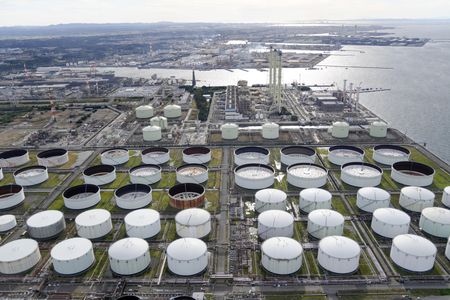By Scott DiSavino
NEW YORK (Reuters) -Oil futures eased about 1% on Thursday, as traders took profits after prices soared to 10-month highs, and some worried that high interest rates may weigh on oil demand.
On its second to last day as the front-month, Brent futures for November delivery fell $1.17 or 1.2%, to settle at $95.38 a barrel. Brent November futures expire on Friday.
Brent December futures <LCOc2> fell about 1.3% to settle at $93.10 per barrel.
U.S. West Texas Intermediate crude (WTI) fell $1.97, or 2.1%, to settle at $91.71 per barrel.
Earlier, scarce supply and inventory supplies lifted the Brent front-month hit $97.69, its highest since November 2022. WTI rose to its highest since August 2022 at $95.03.
“Oil was ripe for a pullback. After coming a few dollars short of the $100 level, energy traders are quickly locking in profits,” Edward Moya, senior market analyst at data and analytics firm OANDA, said in a note.
Some traders worried high oil prices will stoke inflation, encouraging the U.S. Federal Reserve and other central banks to persist with high interest rates.
“Crude is now serving as a catalyst for bearishness … as investors view high oil prices as reason for the Fed to persist with high rates for longer than originally planned in order to curb inflation,” analysts at energy consulting firm Gelber & Associates said in a note.
The U.S. economy maintained a fairly strong 2.1% pace of growth in the second quarter and appears to have gathered momentum this quarter with a resilient labor market driving strong wage gains.
Growth estimates for the July-September quarter are currently as high as a 4.9% rate. But the fourth quarter could see a sharp slowdown if there is a U.S. government shutdown on Oct. 1.
Fed officials are focused on the super core price measure after hiking the benchmark overnight interest rate by 525 basis points since March 2022 to the 5.25%-5.50% range.
FALLING US INVENTORIES
The premium of the WTI front-month over the second month held near a 14-month high for a second day. The market structure called backwardation occurs when spot prices are higher than future prices, giving energy firms little incentive to pay to store fuel for future months.
On Wednesday, WTI backwardation soared 48% to $2.38 a barrel, the highest since the end of July 2022, after government data showed stocks at the Cushing, Oklahoma, storage hub and delivery point for U.S. crude futures, extended their drawdown, also to the lowest since July 2022. [EIA/S]
“Cushing storage has shrunk to a historically low level, leading to a further increase in backwardation in the WTI curve,” analysts at Barclays, a bank, said in a note.
“In the absence of a demand shock, it might take a sustained further narrowing of the WTI-Brent spread for a material turnaround in storage level at Cushing to occur,” Barclays said.
Cushing’s levels have slid to near historic lows due to strong refining and export demand, prompting concerns about quality of the remaining oil.
Meanwhile, tight prompt U.S. supplies have also narrowed the premium of Brent over WTI held near a five-month low after falling to $2.87 per barrel on Wednesday, its lowest since late April.
Falling U.S. crude inventories follow combined cuts of 1.3 million barrels per day to the end of the year by Saudi Arabia and Russia, part of OPEC+, the Organization of the Petroleum Exporting Countries (OPEC) and allies.
Russia said its ban on fuel exports will remain in place until the domestic market stabilizes and noted it has not discussed with OPEC+ a possible supply increase to compensate for that fuel export ban.
(Reporting by Scott DiSavino in New York, Natalie Grover in London, Florence Tan in Singapore and Mohi Narayan in New Delhi; Editing by Marguerita Choy and David Gregorio)






